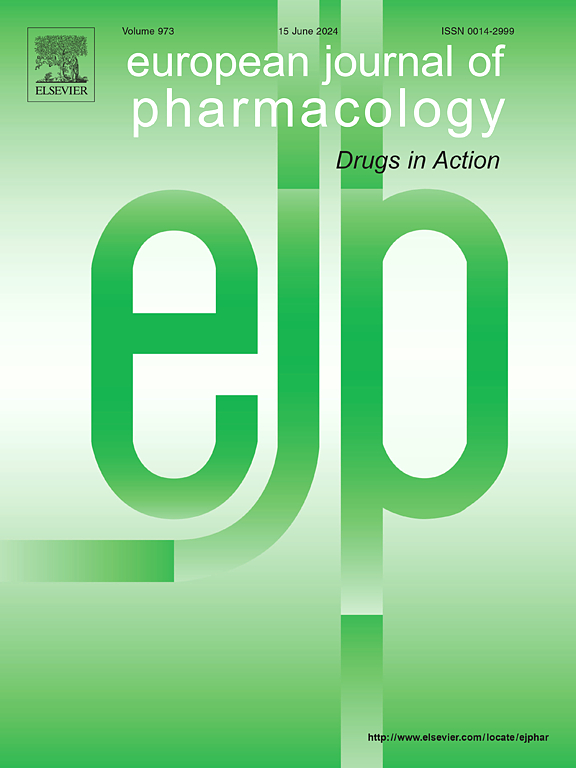西洛他唑通过靶向SIRT1/AMPK/PGC-1α信号通路,影响miRNA-34a,减轻顺铂诱导的急性肝损伤
IF 4.2
3区 医学
Q1 PHARMACOLOGY & PHARMACY
引用次数: 0
摘要
顺铂(CP)是一种主要的化疗药物,被广泛用于治疗各种癌症。尽管效果显著,但顺铂的使用与严重的肝毒性有关。西洛他唑(CSZ)是一种选择性磷酸二酯酶 III 抑制剂,最近在不同疾病中表现出显著的抗炎和抗凋亡特性。此外,它还对各种形式的肝损伤具有保肝作用。因此,本研究旨在评估 CSZ 对 CP 诱导的急性肝损伤(ALI)的潜在保肝和改善作用,并阐明其潜在的分子机制。为此,雄性 Wistar 大鼠在口服 CSZ(5 或 10 毫克/千克)一周后,单次注射 CP(20 毫克/千克;静注)诱导 ALI。研究结果表明,CSZ 能有效逆转 CP 引起的肝功能障碍,肝功能测试结果和组织学检查结果均有明显改善。此外,CSZ 还能降低 MDA 水平,提高 GSH 和 GPx 水平,增强 SOD 活性,从而抵御 CP 介导的肝脏氧化应激。此外,CSZ 还能有效抗炎,减少促炎细胞因子的表达,包括 NF-κB、IL-1β 和 TNF-α。在肝细胞凋亡方面,CSZ 可抑制 Bax 免疫表达、caspase-3 和 caspase-9 水平,同时提高 Bcl-2 表达,从而减轻肝细胞死亡。CSZ 的保肝作用可能是由于调控了 miRNA-34a/AMPK/SIRT1/PGC-1α 信号通路,从而激活了 Nrf2/HO-1 介导的抗氧化防御机制。总之,CSZ可能是预防CP诱发ALI的一种有前途的治疗药物,有可能改善癌症患者的生活质量。本文章由计算机程序翻译,如有差异,请以英文原文为准。

Cilostazol attenuates cisplatin-induced acute liver injury by targeting the SIRT1/AMPK/PGC-1α signaling pathway, with an impact on miRNA-34a
The dominant chemotherapeutic agent, cisplatin (CP), is widely used to manage various cancer types. Despite its effectiveness, CP use is associated with severe hepatotoxicity. Cilostazol (CSZ), a selective phosphodiesterase III inhibitor, has recently demonstrated remarkable anti-inflammatory and anti-apoptotic properties in different diseases. Additionally, it exhibits hepatoprotective effects against various forms of liver injury. Hence, this study aimed to assess the potential hepatoprotective and ameliorative effects of CSZ on CP-induced acute liver injury (ALI) and to elucidate the underlying molecular mechanisms. To achieve this, ALI was induced by a single injection of CP (20 mg/kg; i.p.) in male Wistar rats pretreated with CSZ (5 or 10 mg/kg) administered orally for one week. The findings revealed that CSZ effectively reversed CP-induced hepatic dysfunction, as evidenced by notable liver function tests and improvements in histological examination. Additionally, CSZ protected against CP-mediated liver oxidative stress by decreasing MDA levels while increasing GSH and GPx levels and enhancing SOD activity. Furthermore, CSZ exhibited a potent anti-inflammatory effect, reducing the expression of pro-inflammatory cytokines, including NF-κB, IL-1β, and TNF-α. Regarding hepatocyte apoptosis, CSZ suppressed Bax immunoexpression and caspase-3 and caspase-9 levels while enhancing Bcl-2 expression, thereby mitigating hepatic cell death. The hepatoprotective effects of CSZ could be attributed to the regulation of the miRNA-34a/AMPK/SIRT1/PGC-1α signaling pathway, leading to the activation of the Nrf2/HO-1-mediated antioxidative defense mechanism. In conclusion, CSZ could be a promising therapeutic agent for preventing CP-induced ALI, potentially improving the quality of life for cancer patients.
求助全文
通过发布文献求助,成功后即可免费获取论文全文。
去求助
来源期刊
CiteScore
9.00
自引率
0.00%
发文量
572
审稿时长
34 days
期刊介绍:
The European Journal of Pharmacology publishes research papers covering all aspects of experimental pharmacology with focus on the mechanism of action of structurally identified compounds affecting biological systems.
The scope includes:
Behavioural pharmacology
Neuropharmacology and analgesia
Cardiovascular pharmacology
Pulmonary, gastrointestinal and urogenital pharmacology
Endocrine pharmacology
Immunopharmacology and inflammation
Molecular and cellular pharmacology
Regenerative pharmacology
Biologicals and biotherapeutics
Translational pharmacology
Nutriceutical pharmacology.

 求助内容:
求助内容: 应助结果提醒方式:
应助结果提醒方式:


